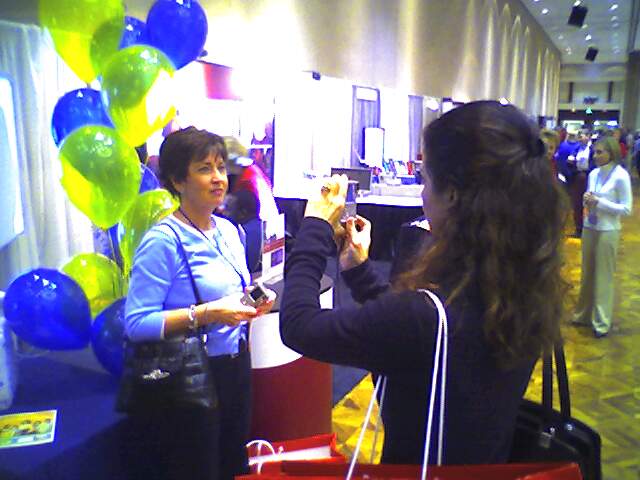Yesterday was a very good day. I taught An Educator’s Guide to Blogging and An Educator’s Guide to Podcasting. The podcasting session was a little tough because OurMedia seemed to be experiencing some load problems. I suspect that I’m going to, at some point spring for a commercial host for my podcasts, but that’s for later.
 After those three-hour workshops, I spent a little time at the exhibitor’s opening. There seemed to be fewer booths set up, with more of the companies springing for larger areas. Apple, always a big presence at NCETC has a keyboard lab set up for teaching music via a network. This looks very interesting, but I’ll likely not have time to investigate. I also looked as some of the new modules in SAS inSchool, and was quite impressed. I could not put my finger on it, but there was something about the experience of running through the module that took me back a couple of decades ago, with some of the old laserdisc products. It was exciting, because we seemed to be looking for richer more interactive experiences for our students then, than we do now. And SAS inSchool pulls it off so elegantly.
After those three-hour workshops, I spent a little time at the exhibitor’s opening. There seemed to be fewer booths set up, with more of the companies springing for larger areas. Apple, always a big presence at NCETC has a keyboard lab set up for teaching music via a network. This looks very interesting, but I’ll likely not have time to investigate. I also looked as some of the new modules in SAS inSchool, and was quite impressed. I could not put my finger on it, but there was something about the experience of running through the module that took me back a couple of decades ago, with some of the old laserdisc products. It was exciting, because we seemed to be looking for richer more interactive experiences for our students then, than we do now. And SAS inSchool pulls it off so elegantly.
I also had a long conversation with Chuck Swaim, of Eperitus. We talked about some of the video networking that they are doing with schools, and the paradigm shifts that they should be suggesting. Still, the model continues to be stand and deliver. Perhaps it’s more like mount (the display) and shine, but we seem to insist on remaining the gatekeepers of knowledge, delivering to our students. What came to mind as we talked was the fact that this model seems to insist on barriers between the source of the knowledge and the learner. For the teachers, it’s that space between the teacher’s desk or their space for pacing, and where students reside. For video delivery, it’s the display glass.
But today we have keyboards and mice giving students the chance to interact with the information and knowledge. We can put the video camera into the hands of our students and have them aim at their world, record, and build knowledge from it. It would be good for teachers to record their lectures and make them available to students during the summer for what Swaim called “repetitives”. But why not give students access to the files, and ask them to remix the lectures with additional multimedia resources, additional lectures, and even aim the camera on themselves and reflect.
Sadly, I saw little evidence of this pie in the sky idea within the walls of the exhibit hall. In fact there seemed to be more products designed to give teachers more control over learning instead of less. I hate to complain about the very smart, well-meaning, and in most cases cleverly implemented products. But we aren’t teaching the kids we think we are. The kids in are classrooms are not like us. We need to figure this out.
I had dinner last night with Bernajean Porter, one of today’s keynote speakers. We’ve met a couple of times at past conferences, but not had a chance to talk. First of all, I’m not in her league, especially considering that I’d been up for 19 hours. She’s very smart, and gets education at many different levels, and she seems focused on where the leverage points are for change. She’s very good, and she suggested far more ideas during that hour than I could ever have grasped or even remembered, even if I were less fatigued.
But the gist was this. We have been so successful for so long, that we think we’ve got it right, and that if we just do it harder, for more hours of the day, and with more control, then our kids will be as well prepared as we were (for the 1950s).
We, the education industry, are focused on momentum. We need to be focusing on the goal (citizens who are ready for the 21st century), and doing what ever it takes to get there. Amen!

It amazes me to see how many teachers still have their classrooms set up in neat rows and columns. Naturally, this sets up a scenario for industrial-aged education where everyone does the same thing at the same time focusing on the teacher. The teacher leads the class and everyone follows the direction of the teacher. Student inquiry is not encouraged or generally allowed. Unfortunately, our society has moved on to the Digital Age. How much longer will it take our schools to catch up with this shift?
Todays students are different. They communicate and interact differently then we do. How much longer will we try to fit a square peg in a round hole?